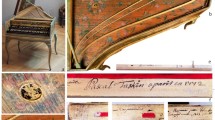Abstract
Non-destructive testing methods are very important tools for conservators and art historians to obtain valuable information about works of art without causing any or even local damage to them. Two successful case studies showing the noticeable potentialities of two analytical portable instruments employed in the characterisation of tangible cultural heritage are shown. The first example concerns the chemical characterisation via an X-ray fluorescence (XRF) portable instrument of the red decorative pigment and of the stone surface of the Capestrano Warrior (Archaeological Museum of Chieti, Italy), which is considered the most important Italic stone statue found in Italy. The second concerns the use of a portable electrochemical impedance spectroscopy (EIS) measurement system for the characterisation of the protective effectiveness of the paints on the railing of Palazzo Reale in Torino, Italy.
Similar content being viewed by others
References
E. Angelini, G.M. Ingo, F. Rosalbino, T. De Caro, S. Grassini, Metall. Ital. 7–8, 9 (2003)
G. Moretti, Il Guerriero Italico di Capestrano (, Rome, 1936)
L. Mariani, L’Aufidena, in Monumenti Antichi dei Lincei, vol. 10 (, 1901), col. 225
V. Cianfarani, Antiche Civiltà d’Abruzzo (, Rome, 1969)
P.F. Stary, Zur Eisenzeitlichen Bewaffnung und Kampfweise in Mittel-Italien (, Mainz, 1981)
R. Salvia del Rosario, Necropoli archaiche d’Abruzzo: la necropoli di Capestrano. In Papers in Italian Archaeology IV: part iii, Patterns in Protohistory (B.A.R. Int. Ser. 245) (Cambridge, 1985)
G. Paternoster, R. Rinzivillo, F. Nunziata, E.M. Castellucci, C. Lofrumento, J. Cult. Herit. 6, 21 (2005)
A. Longoni, C. Fiorini, P. Leutenneger, G. Fronterotta, L. Struder, P. Lechner, Nucl. Instrum. Methods Phys. Res. A 409, 407 (1998)
A.G. Karydas, D. Kotzamani, R. Bernard, J.N. Barrandon, C. Zarkadas, Nucl. Instrum. Methods Phys. Res. B 226, 15 (2004)
G. Cultrone, G. Barone, G. Cangemi, S. Ioppolo, J. Cult. Herit. 2, 199 (2001)
W.J. Lorenz, F. Mansfeld, in Fundamental Aspects of Corrosion Protection by Surface Modification, ed. by E. McCafferty, C.R. Clayton, J. Oudar (Proc. Ser. PV 84-3) (The Electrochemical Society, Pennington, NJ, 1984), p. 144
C. Price, D. Hallam, G. Heath, D. Creagh, J. Ashton, An electrochemical study of waxes for bronze sculpture. In Metal95 – International Conference on Metal Conservation, Semur en Auxois, France, 25–28 September 1995, ed. by I.D. MacLeod, S.L. Pennec, L. Robbiola (James & James, , 1997), pp. 233–241
L.A. Ellingson, T. Shedlosky, G.P. Bierwagen, E.R. de la Rie, L.B. Brostoff, Stud. Conserv. 49, 53 (2004)
L.B. Brostoff, E.R. de la Rie, Research into protective coating system for outdoor bronze sculpture and ornamentation. In Metal95 – International Conference on Metal Conservation, Semur en Auxois, France, 25–28 September 1995, ed. by I.D. MacLeod, S.L. Pennec, L. Robbiola (James & James, , 1997), pp. 242–244
A. Carullo, F. Ferraris, M. Parvis, E. Vallan, E. Angelini, P. Spinelli, IEEE Trans. Instrum. Meas. 49, 371 (2000)
Author information
Authors and Affiliations
Corresponding author
Additional information
PACS
68.55.Jk; 68.35.Dv; 68.37.Hk; 68.55.Nq; 81.05.Bx
Rights and permissions
About this article
Cite this article
Angelini, E., Grassini, S., Corbellini, S. et al. Potentialities of XRF and EIS portable instruments for the characterisation of ancient artefacts. Appl. Phys. A 83, 643–649 (2006). https://doi.org/10.1007/s00339-006-3546-8
Received:
Accepted:
Published:
Issue Date:
DOI: https://doi.org/10.1007/s00339-006-3546-8



